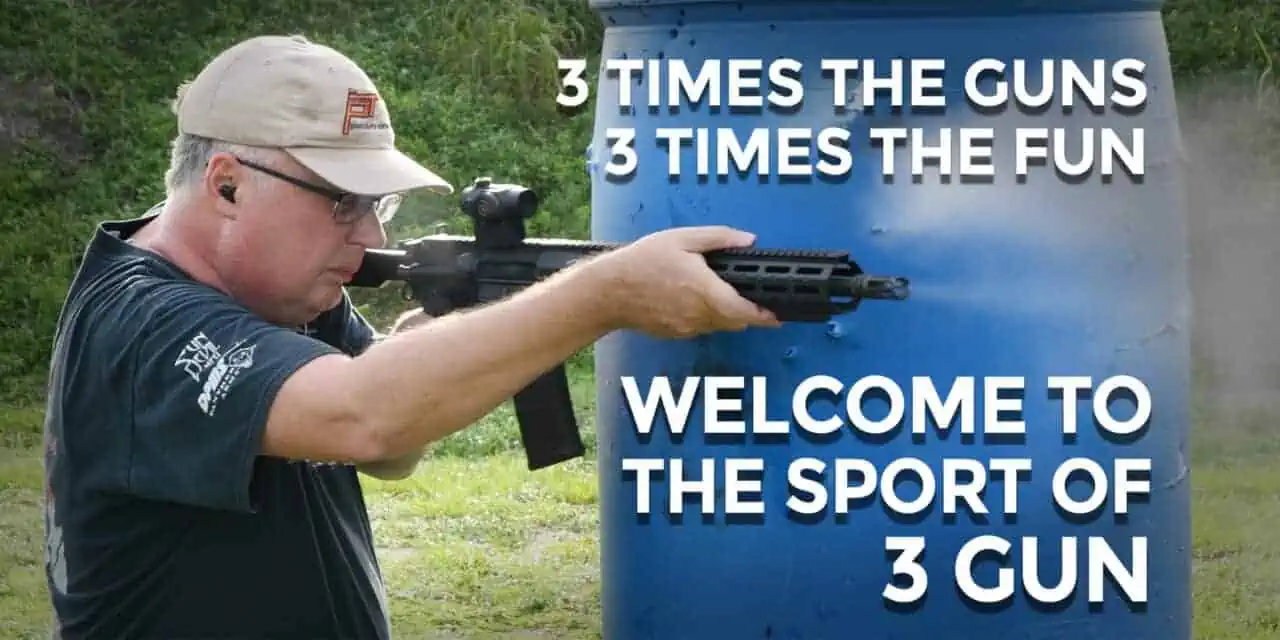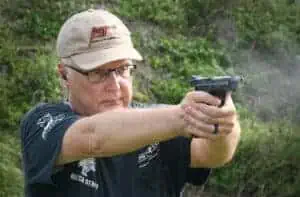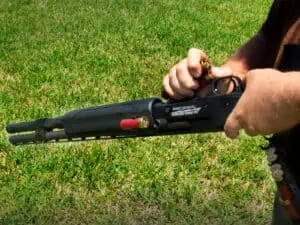A Beginner’s Guide To 3 Gun Competition
The sport of jousting was created to help medieval knights perfect the skills they would need in the real world. The original Olympic games, the ones held in ancient Greece, had events such as javelin throwing and wrestling that were quite similar to the same skills their warriors were learning. Ancient cultures knew that competition could be an effective way to improve the quality of their warriors. The same is true for the modern firearms owner. Practical shooting is an enjoyable way to hone many of the skills you might need in a defensive encounter. IDPA and USPSA are two of the most popular practical sports around, but they are primarily pistol-focused. There is more to defensive firearms than just pistols, though, and that’s where 3 Gun comes in.
3 Gun is a practical shooting sport which uses three guns, a rifle, a pistol, and a shotgun. A 3 Gun competition is composed of a number of stages, and each stage has a course of fire that must be negotiated by the competitors. Competitors shoot in different divisions, according to how their guns are set up. All three guns (rifle, pistol, shotgun) may be used on one stage, or some stages may be dedicated to just one firearm. Scoring methods vary (more on that later), but in general, the competitor who competes all the courses of fire in the shortest amount of time wins the match. Sounds complicated, but in reality, a successful match in 3 Gun can be boiled down to “Shoot fast, don’t miss.”
Who’s In Charge Here?
Let’s talk about scoring and governing bodies. Unlike practical pistol, where USPSA or IDPA are the dominant governing bodies of the sport, there is no single overarching set of rules that governs 3 Gun competitions. This is due, in part, to how the sport began. 3 Gun started as an offshoot of the annual Soldier of Fortune convention in Las Vegas, Nevada. In keeping with the spirt of the convention, the match was designed around “real world” encounters. It also required guns that were in common use by the world’s militaries and law enforcement agencies. The format of the match was soon picked up by other clubs, and thus the sport of 3 Gun was born.
As was mentioned before, there is no single governing body which covers the entire sport of 3 gun. “Outlaw” matches are quite common, as are competitions run by the IMG (International Multigun) rules used by many of the larger matches. There is also 3 Gun Nation, and the USPSA has Multigun rules as well. In essence, though, all the divisions are very similar, no matter who is running the match. 3 Gun competition sorts out competitors by what gear they use, just like other practical shooting sports. Under IMG rules, competitors are placed into one of five different divisions.
Limited Division:
The rifle may have one non-magnifying optic, and all other guns must use iron sights. Typical gear for this division is an AR-15 pattern rifle with a red dot or holographic sight. Other gear includes a 12 gauge semi-automatic shotgun which holds eight rounds in the magazine, and a double-stack 9mm pistol that holds at least 15 rounds in the magazine.
Tactical Division:
This division is very similar to Limited Division, except that the rifle may have magnification. This is where you see rifles running low-power variable optics (LVPO) mounted on rifles. These give true one-power magnification for fast shots at close range, but easily switch over to 4 power (or more) for long distance. Other than the optic, though, the gear in this division is almost identical to Limited Division.
Stealth Division:
The newest division in the sport. The gear in this division can look similar to Open Division, but it is more focused on “real world” applications. Race holsters and shotgun speedloaders are banned, but your rifle, pistol and shotgun can all have an optic on them if so desired.
Open Division:
Welcome to the world of race guns. Equipment in this division is optimized for 3 Gun, and not much else. Box-fed shotguns with red dots, pistols with dot sights and quick-draw holsters along with rifles with huge muzzle brakes are par for the course in this division. So is shelling out thousands of dollars for the absolute best in guns and gear.
Heavy Metal Division:
Think the .223 round is nothing but a “poodle shooter?” Don’t trust any handgun caliber that doesn’t start with the number 4? Then this is the division for you! Heavy Metal is where AR-10 rifles and double-stack 1911-style pistols come out to play. It’s also the only division where a pump-action shotgun is not at a huge disadvantage compared to other shotgun types. If you’re a fan of larger calibers, this is where you should be.
Why shoot a 3 Gun Competition?
One of the biggest reasons to shoot 3 Gun is it’s fun. Ridiculously fun. There’s a saying in the sport, “Three times the guns, three times the fun,” and it’s 100% true. You’ll be pushing your skills with the pistol, rifle, and shotgun to their absolute limits at a match. You’ll also find out how well you perform under pressure, a valuable skill for any defensive firearm owner. Best of all, you’ll meet some great people who will help you get better and improve as you shoot more and more. The competitors at a 3 Gun competition (or any practical shooting match, for that matter), are always willing to help out new shooters and get them up to speed in the sport.
So what are some of the downsides to shooting a 3 Gun competition? Well, it’s not cheap. Three times the guns may mean three times the gun, but it also means at least three times the money spent on guns. A stock full size 9mm pistol will suffice, but an AR-15 with an optic is going to cost at least $1000. The price for an entry-level shotgun is around $800, and it goes up from there.
Thrills, But Not Cheap Thrills
In addition to this, there is the cost of the ammunition. A typical practical pistol match consists of three or four stages that require 20-30 rounds each to complete. This means that you’ll need to take 150 rounds or so to the range with you when you go. A typical 3 gun match usually has the same four stages, but the round count for each gun can vary greatly. Shooting 30 rounds of 9mm on a stage is one thing. Shooting 30 rounds of 223 (or 308, if you’re shooting Heavy Metal) is something else.
Lastly, just like any combat-related sport like boxing or jiu jitsu, there is a gap between what works in competition, and what works in real life. 3 Gun matches are often set up to encourage fast movement from target to target. They also rarely require the use of cover while shooting. In addition to this, some skills that are essential to winning a 3 gun competition, like shotgun quad loading, don’t work well outside of the range.
Despite these downsides, you will learn some valuable skills shooting 3 Gun. You’ll quickly learn to run your guns and shoot well in stressful situations, a skill that is 100% applicable to the real world. You’ll learn the limits of your marksmanship, and then go beyond them, making shots that you couldn’t have made before. If you’re looking for something that will push your abilities with all the guns in your gun safe, check around for a local match and give 3 Gun a shot. You may just have the time of your life.





